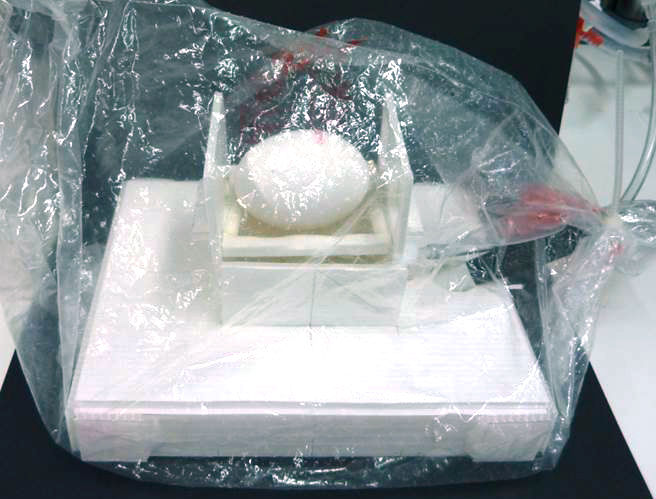Live from the hen’s egg
Göttingen scientists have, for the first time, filmed hatching chicks in real time using magnetic resonance imaging (MRI). The team of the Biomedizinische NMR Forschungs GmbH at the Max Planck Institute for Biophysical Chemistry succeeded in visualizing the embryo’s daily stages of development within the intact eggshell, as well as its subsequent hatching.

The self designed breeding cavity consisted of a mouse cage, a heater spiral and a ventilated plastic bag. The air humidity was ensured by a little water basin beneath the egg.
© Max Planck Institute for Biophysical Chemistry
Like a contortionist, twisted the chick is lying in its eggshell, brain, eyes, and beak visible in levels of grey. In small white circles, the flowing blood of the active chick flashes again and again on the MRI system’s monitor. The chick bumps with its head back and forth and finally cracks the eggshell. Scientists at the Biomedizinische NMR Forschungs GmbH have now managed to film the natural embryonic development and hatching of a chicken in real time through MRI. To accomplish this, the researchers scanned fertilized eggs in a clinical MRI system with a unique imaging technique at an acquisition speed of 12 frames per second.
Siegfried Machemehl, chairman of the Poultry Breeding Club Göttingen-Grone, provided fertilized eggs of the Marans breed. "The rather large Marans eggs, weighing about 65 grams each, were a real stroke of luck for us. The larger the egg, the more detailed the features we can observe," project leader Roland Tammer reveals. At the beginning of the research project, chicken eggs incubated for ten days were transferred to a regular incubator at the institute at 37.5 degrees Celsius and 70 to 90 percent humidity.
Each day at exactly the same time, researchers Shuo Zhang and Arun Joseph withdrew one of the eggs and adjusted it between the receiver coils normally used to examine human temporomandibular joints. A self-designed breeding cavity, which was ventilated and heated, maintained the breeding conditions during the subsequent measurements in the MRI system.
"Crucial for us was to observe the natural dynamics of the chicken embryo," Tammer emphasizes. The unpredictable movements inside the egg during image acquisition, however, were a true challenge for the scientists. "The stronger the chick moved, the more complicated it became to keep the scan plane and to exactly recognize all the details", Tammer explains. In order to obtain comparable cross-sectional images, the egg was always aligned in the same way. The head of the spirally-rolled bird was the main reference point. "We have focused on the brain and the vitreous body of the eye as bright and distinctive identifying features. These were the easiest to find despite all movements", says the scientist. From day 20 of development on, the researchers also performed longitudinal imaging along the body and documented the positions of the limbs and internal organs. In addition to the observation of the daily embryonic development in detail, the primary research interest focused on the hatch dynamics.
60,000 images of the hatching chick
The hatch itself is subject to biological variation. After 18 days, the chick is fully developed, but only after 21 days is it ready to leave the eggshell. The hatching process can take only a couple of hours but can also last up to three days. Hatching of the scanned Marans chick dragged on for more than 36 hours. Including breaks the chick remained 24 of the 36 hours in the MRI system. "It was incredibly exciting to see how his chest worked and what tremendous efforts the chick had to make to get free," the project leader says. In different image series, about 60,000 MRI images were taken within the last 13 hours of hatching alone. From the very last 45 minutes of the hatching process, two videos were produced using the real-time MRI technology termed FLASH 2 and powerful graphics processing computers.
The team of Jens Frahm, head of the Biomedizinische NMR Forschungs GmbH, developed FLASH 2 in 2010. It allows extremely fast imaging speeds of up to 50 frames per second via the combined use of dedicated acquisition and reconstruction strategies. In contrast to X-ray methods, FLASH 2 – like all other MRI techniques – is harmless to the organism under examination. "Using FLASH 2 we could visualize the chick’s movements inside the narrow eggshell without disturbing it. This method is promising to pave the way for various real-time medical applications," Tammer looks ahead.























































